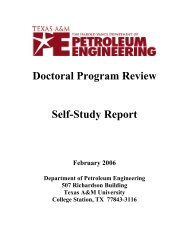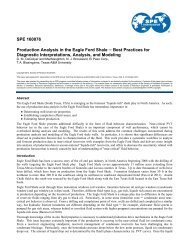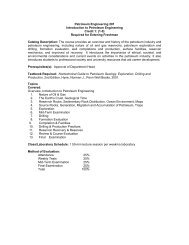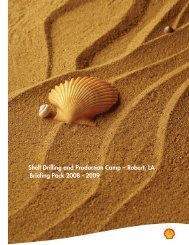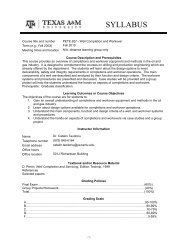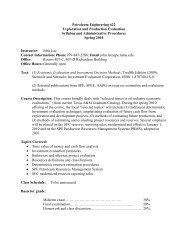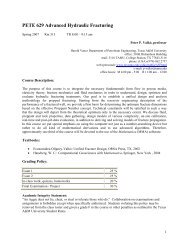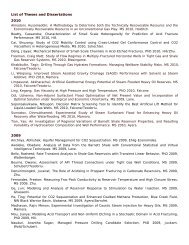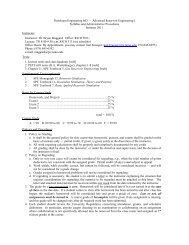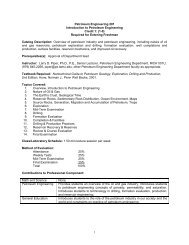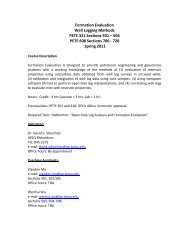Crisman Annual Report 2009 - Harold Vance Department of ...
Crisman Annual Report 2009 - Harold Vance Department of ...
Crisman Annual Report 2009 - Harold Vance Department of ...
You also want an ePaper? Increase the reach of your titles
YUMPU automatically turns print PDFs into web optimized ePapers that Google loves.
Investigation <strong>of</strong> Hybrid Steam-Solvent Processes to Increase Efficiency <strong>of</strong> Thermal<br />
Oil Recovery Methods<br />
Objectives<br />
Steam assisted gravity drainage (SAGD) has received<br />
considerable attention as a proven technique to<br />
recover heavy oil and bitumen which are immobile<br />
at reservoir conditions. The main drawbacks <strong>of</strong> this<br />
process are high energy intensity (steam generation<br />
requirements) and environmental issues.<br />
The addition <strong>of</strong> light hydrocarbon solvents to steam is<br />
the simplest and most important approach to improve<br />
SAGD process and reduce potential problems. Main<br />
benefits possibly obtained by a hybrid steam solvent<br />
process include: reduced Steam Oil Ratio, reduced<br />
environmental impact, increased recovery via<br />
reduced S or<br />
, reduced capital to startup and enhanced<br />
well productivity. Principal challenges are the choice<br />
<strong>of</strong> solvent and concentration and operating strategy.<br />
Our main research objective is to reduce energy<br />
intensity <strong>of</strong> SAGD process by using solvents<br />
and investigate the effect <strong>of</strong> different operating<br />
strategies. Key tasks are to evaluate the effect on<br />
oil recovery <strong>of</strong> the following:<br />
» Solvents, (e.g., butane, hexane and condensates)<br />
» Solvent concentration<br />
» Injection types (e.g., cyclic steam solvent injection)<br />
Fig. 1. Simulation results <strong>of</strong> oil recovery.<br />
with increasing concentration. The aluminum 2D<br />
cylindrical model is under construction. The sandmix<br />
space has an inner radius <strong>of</strong> 4 in, 1-in thickness, and<br />
10-in height, and will be lined with insulating Teflon<br />
layers (Fig. 2). The experimental set up is shown<br />
in Fig. 3.<br />
Approach<br />
Experiments will be carried out in a scaled 2D<br />
cylindrical cell to evaluate the effect <strong>of</strong> steam-solvent<br />
processes. Pujol and Boberg’s scaling method has<br />
been used to design the model. Advantages <strong>of</strong> the<br />
cylindrical model are the relatively high pressure<br />
capability without a pressure jacket, the use <strong>of</strong> inner<br />
thermal insulation, and the ability to conduct gravity<br />
drainage experiments (e.g., VAPEX, SAGD). Oil and<br />
water production, gas composition, and temperature<br />
would be measured and analyzed. Numerical<br />
simulation will be used for parametric studies.<br />
Accomplishments<br />
Compositional reservoir simulation studies <strong>of</strong> Cold<br />
Lake bitumen were performed to investigate the<br />
effect <strong>of</strong> solvent type and concentration on recovery<br />
under SAGD at 220°C and 3100 kpa (450 psia)<br />
(Fig. 1). With C5-C7 as solvents, bitumen recovery<br />
increases to about 80% at 20 wt%. C2 and C3<br />
however exist as vapor and act as thermal insulators<br />
at the steam-bitumen interface, reducing recovery<br />
Project Information<br />
1.3.22 Investigation <strong>of</strong> Hybrid Steam-Solvent Injection to<br />
Increase Efficiency <strong>of</strong> Thermal Oil Recovery Processes<br />
Related Publications<br />
Nasr T.N., and Ayodele O.R. New Hybrid Steam-Solvent<br />
Processes for the Recovery <strong>of</strong> Heavy Oil and Bitumen.<br />
Paper SPE 101717, presented at the 2006 International<br />
Petroleum Exhibition and Conference, Abu Dubai, UAE, 5-8<br />
November.<br />
Ayodele, O.R., et al. Laboratory Experimental Testing<br />
and Development <strong>of</strong> an Efficient Low Pressure ES-SAGD<br />
Process. <strong>2009</strong>. J. Cdn Pet. Tech. 48 (9).<br />
Contacts<br />
Daulat Mamora<br />
979.845.2962<br />
daulat.mamora@pe.tamu.edu<br />
Mojtaba Ardali<br />
CRISMAN INSTITUTE<br />
36<br />
<strong>Crisman</strong> <strong>Annual</strong> <strong>Report</strong> <strong>2009</strong>



